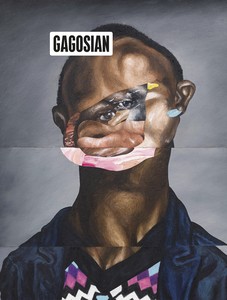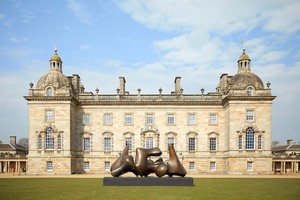
Now available
Gagosian Quarterly Fall 2019
The Fall 2019 issue of Gagosian Quarterly is now available, featuring a detail from Sinking (2019) by Nathaniel Mary Quinn on its cover.
A giant of modernism, Henry Moore engaged the abstract, the surreal, the ancient, and the classical in corporeal forms and organic images—in conjunction with natural found objects such as bones and stones—that are at once accessible and avant-garde. His sculptures, with their imposing physicality combined with pierced forms and hollow spaces, promote a charged interaction between the work, its site, and the viewer. Moore’s oeuvre celebrated humanist themes at a time when traditional representation was largely eschewed by the vanguard art establishment.
Moore was born in 1898 in the English mining town of Castleford, near Leeds. After teaching at Castleford Grammar School, he fought in the First World War and, on his return from France in 1919, enrolled at Leeds School of Art, where he was joined by fellow artist Barbara Hepworth. He won a scholarship to study at the Royal College of Art, London, from 1921 to 1924, and while there, he made Mother and Child (1922), his first sculpture on a subject that would fascinate him throughout his life. He also received traveling scholarships to Paris (1923) and Italy (1925). Afterward, Moore taught in London, first at the Royal Academy Schools from 1924 to 1932, and then at Chelsea School of Art from 1932 to 1939.
Moore was innovative from the beginning of his career. For instance, in 1922 he used an experimental pen, ink, chalk, and wash combination in Standing Nude Girl, One Arm Raised, and in 1926 he employed cast concrete, a material that was largely confined to architecture at the time, to create Head of a Woman. Moore achieved early success. His debut solo exhibition was held at the Warren Gallery, London, in 1928. That same year, he completed his first public commission, installed at the headquarters of the London Underground. During the 1930s, Moore absorbed the influence of artists such as Alberto Giacometti, Pablo Picasso, and the Surrealists, and so developed a more abstract approach to his own practice. In 1938 he met Sir Kenneth Clark, who became a significant early supporter of his work.

The Fall 2019 issue of Gagosian Quarterly is now available, featuring a detail from Sinking (2019) by Nathaniel Mary Quinn on its cover.

Sebastiano Barassi reflects on the centrality of nature in the work of Henry Moore—as form, material, inspiration, and site.

A look inside the Henry Moore Foundation, their new initiatives, and what’s next.
Request more information about
Henry Moore